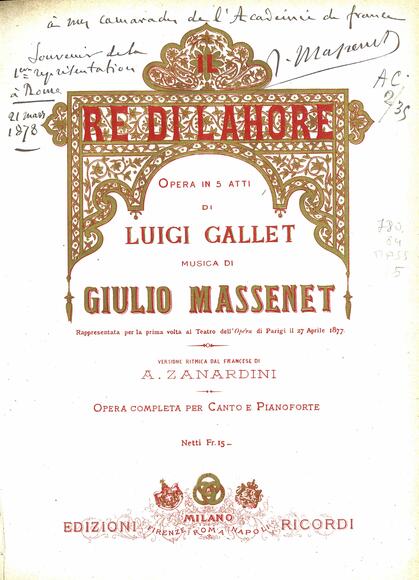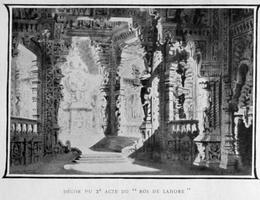Le Roi de Lahore

Opera in 5 acts premiered at the Paris Opéra on 27 April 1877.
A young priestess, threatened with forced marriage to the future king, is reunited with her lover and the true sovereign, who has returned from beyond the grave to spend a few final moments with her. From an Indian legend retold in Voyage autour du monde by the Marquis de Beauvoir, Louis Gallet charted the story of Sitâ and Alim’s unwavering love for each other. The storyline immediately filled Massenet with enthusiasm: he was delighted to work again with Gallet, who had been such an invaluable collaborator on Marie-Magdeleine and to have such a well-structured libretto at his disposal. Not only that, but the supernatural aspect of the scene in the Paradise of Indra–a new feature for the genre–was handled with such dexterity by Gallet that it was utterly compelling. Begun as early as 1873, the composition was completed early in the summer of 1876. Massenet wrote the work without any concern for the location of its premiere, although he knew he would need a large theatre. The day after a chance encounter, he offered Halanzier, director of the Paris Opéra, a strong and coherent score. The structure is modelled on a format inherited from Gounod and Ambroise Thomas, alternating large ensembles, duets and arias, with particular importance placed on the arioso. Massenet seems to have rejected the strict grammar of grand opera in this work and confessed to “being Wagnerian, probably too much so” in the writing. The composer certainly used recurring motifs, but their role was restrained and the richness of the score came from the melodic inventiveness, which required great versatility and vocal range from the singers. The fairly standard orchestra called for a contrabass tuba, then manufactured by Adolphe Sax, tenor saxhorns in the wings and chromatic trumpets which were somewhat rare at the time. And, above all, a tenor saxophone for the magnificent waltz in the ballet.
Scientific publications
Publication




